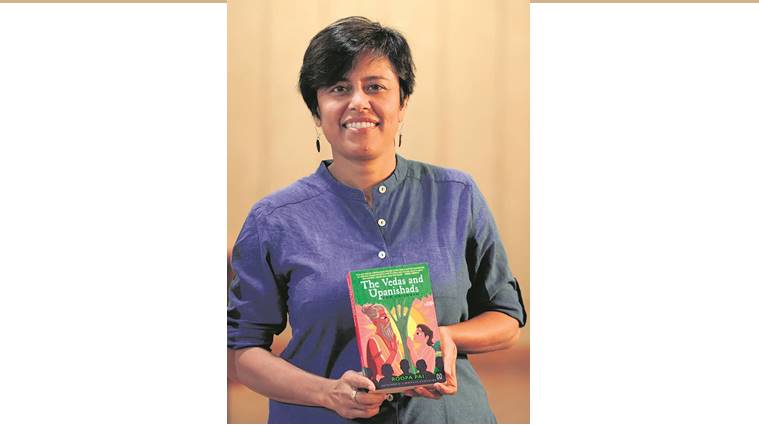Written by Surbhi Gupta |Updated: January 9, 2019 4:02:29 pm
Author Roopa Pai on breaking down the complexities of Vedas and Upanishads for children
In Roopa Pai’s guide to the ancient texts, she takes us to the forest labs of the past, to thinkers and philosophers, who contemplated the universe and reflected on the Vedas

Roopa Pai grew up in a house which did not own a copy of the Gita. “We’re are the Lingayat sect in Karnataka, who are protestant Hindus. We reject the Vedas, for us God is formless, so we don’t believe in worshipping forms of god, and bury our dead. We don’t have a fire at our weddings,” she says. But when 10-year-olds come up to her and tell her they loved her popular interpretation The Gita for Children, she’s happy. Pai has recently written a prequel to the book, The Vedas and Upanishads for Children (Rs 399, Hachette).
In Pai’s guide to the ancient texts, she takes us to the forest labs of the past, to thinkers and philosophers, who contemplated the universe and reflected on the Vedas. “It is very important for children and young people to know about themselves, to understand where their own world view and belief systems come from. This not only gives them a deep sense of identity, but it also lead to confidence and self-love. It roots them in their own culture while allowing them to explore others with an open mind,” says the Bengaluru-based author, who has written several books for children and teens.
Her last two books were So You Want to Know About Economics (Rupa), Ready!: 99 Must-Have Skills For The World-Conquering Teenager (Hachette). She is also known for writing India’s first fantasy-adventure series, Taranauts. She also helms BangaloreWalks, which conducts heritage and culture tours. “The best part about these ancient texts is that they are entirely secular. They are reflections about where the universe came from, the purpose of human life, the meaning of death, the nature of the mind, the nature of the soul, and so on. They are not about god at all. The Gita is more a practical self-help book on how to live joyously in the world than it is a ‘holy book’,” says Pai.
She turned to Sarvepalli Radhakrishnan’s thousand-pager The Principle Upanishads (1953). His book The Bhagavadgita had been the fundamental source for writing The Gita for Children. Of the other philosophers who she turned to, were indologist Patrick Olivelle and spiritual teacher Eknath Easwaran. She also turned to discourses Swami Sarvapriyananda, Resident Swami of The Vedanta Society in New York and Swami Chinmayananda on YouTube. “He was just so funny and dramatic,” she says.
In the book, Pai gets the basics straight on what are the Vedas and who composed them, and the traditional system of studying them. She introduces the concept of Shruti literature and the debate over the origin of Aryas, and dives into the details of the Vedas. After getting a glimpse into the important Sanskrit hymns, she takes the readers into the world of Upanishads and focuses on the ten main scriptures, giving special importance to the four mahavakyas — consciousness is Brahman, I am Brahman, That Thou Art and This Self is Brahman.
Pai had never read the Gita till the time she decided to work on the book. She was apprehensive what if the book turned out to be casteist or sexist or patriarchal, she wouldn’t be able to “whitewash” it for children. But when someone introduced it as a conversation between two best friends — Arjuna and Krishna, she got drawn to the story, and was soon hooked to it. “If you can read and understand Harry Potter at that age, you can get this too,” she says.






















No hay comentarios:
Publicar un comentario